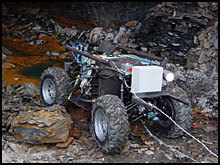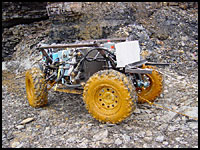ROBOTS IN MINING
Robots will be doing jobs like laying explosives, going underground after blasting to stabilize a mine roof or mining in areas where it is impossible for humans to work or even survive. Some existing examples of mining automation include
· The world's largest "robot", a 3500 tonne coal dragline featuring automated loading and unloading
· A robot device for drilling and bolting mine roofs to stabilize them after blasting
· A pilotless burrowing machine for mining in flooded gravels and sands underground, where human operators cannot go
· A robotic drilling and blasting device for inducing controlled caving.
Robots must demonstrate efficiency gains or cost savings. The biggest robot of them all, the automated dragline swing has the potential to save the coal mining industry around $280 million a year by giving a four per cent efficiency gain. Major production trials of this robot are planned for later in the year 2000.
Unlike their counterparts commonly found in the manufacturing industry, mining robots have to be smart. They need to sense their world, just like humans.
"Mining robots need sensors to measure the three dimensional structure of everything around them. As well as sight, robots must know where they are placed geographically within the minesite in real time and online," says Dr Corke. "CSIRO is developing vision systems for robots using cameras and laser devices to make maps of everything around the machine quickly and accurately, as it moves and works in its ever-changing environment," he says.
Dr Corke insists that the move to robots will not eliminate human miners, but it will change their job description from arduous and hazardous ones to safe and intellectual ones.
The Technology :
Example 1: RecoverBot [2] (used in mine rescue operations) , a one hundred and fifty pound tethered rectangular unit, has two maneuverable arms with grippers and four wheels that support an open box frame with power units, controllers and video cameras separately built with their own individual metal armor. Lowered down the target shaft to prepare a recovery, the telerobotic eyes "see" for the surface controller and the arms move the body into a second lowered net by lifting and dragging. An "aero shell" protects the robot during the lowering operation from a winch to protect from falling debris, and then removed when bottom is reached. Then RecoverBot performs it’s mission, observed from two points of view-the overhead camera used by current mine rescue to image deep shafts-and the robot, who’s video are the mine rescuer’s second view. When the mission is completed the robot is then raised to the surface after the victim and overhead camera is withdrawn.
Example 2: Groundhog [3], a 1,600-pound mine-mapping robot created by graduate students in Carnegie Mellon's Mobile Robot Development class, made a successful trial run into an abandoned coalmine near Burgettstown, Pa. The four-wheeled, ATV-sized robot used laser rangefinders to create an accurate map of about 100 feet of the mine, which had been filled with water since the 1920s.
a 1,600-pound mine-mapping robot created by graduate students in Carnegie Mellon's Mobile Robot Development class, made a successful trial run into an abandoned coalmine near Burgettstown, Pa. The four-wheeled, ATV-sized robot used laser rangefinders to create an accurate map of about 100 feet of the mine, which had been filled with water since the 1920s.
To fulfill its missions, the robot needs perception technology to build maps from sensor  data and it must be able to operate autonomously to make decisions about where to go, how to get there, and more important, how to return. Locomotion technology is vital because of the unevenness of floors in abandoned mines. The robot also must contain computer interfaces enabling people to view the results of its explorations and use the maps it develops.The robot incorporates a key technology developed at Carnegie Mellon called Simultaneous Localization and Mapping (SLAM). It enables robots to create maps in real time as they explore an area for the first time. The technology, developed by Associate Professor Sebastian Thrun of the Center for Automated Learning and Discovery, can be applied both indoors and out.
data and it must be able to operate autonomously to make decisions about where to go, how to get there, and more important, how to return. Locomotion technology is vital because of the unevenness of floors in abandoned mines. The robot also must contain computer interfaces enabling people to view the results of its explorations and use the maps it develops.The robot incorporates a key technology developed at Carnegie Mellon called Simultaneous Localization and Mapping (SLAM). It enables robots to create maps in real time as they explore an area for the first time. The technology, developed by Associate Professor Sebastian Thrun of the Center for Automated Learning and Discovery, can be applied both indoors and out.
"Mining can be a hazardous job. Getting robots to do the job will make mining safer and ensure the long-term viability of the industry".
References:
[1] http://www.spacedaily.com/news/robot-00g.html
[2] http://www.usmra.com/MOLEUltraLight/MOLEUltrLight.htm
[3] http://www.cmu.edu/cmnews/extra/2002/021031_groundhog.html
8 comments:
s0500296 - Martin Wiig
This is very exciting! Mining could be an excellent field where robots are much more fit than humans - hazardous and repetitive enviroments. Robots could also be used in deeper mines than has ever been built, as heat and gases should be no problem for them. They may even be used in mines in space! Clearly, robotic mining has excellent economic potential as well, and can thereby give funding for further robotic research.
U0303270 Quak Yeok Teck
Perhaps one day all our manual labours would be handled by robots or all shapes and sizes. But this is really a good application for robots, to take the place of humans in hazardous jobs. But the effect could also lead to less jobs for the less educated, unemployment rate would rise?
We can see that the impact of robots in society itself.
U0303270 Quak Yeok Teck
Perhaps one day all our manual labours would be handled by robots or all shapes and sizes. But this is really a good application for robots, to take the place of humans in hazardous jobs. But the effect could also lead to less jobs for the less educated, unemployment rate would rise?
We can see that the impact of robots in society itself.
u0206584-Vidhya Ganesan
Quak, I guess you have a point in that robots will steal jobs from men in the long run, thereby increasing the rates of unemployment etc. However, looking at it from a different perspective, human civilisation has always been a quest for the best, constantly striving to improve the quality of life and seek higher and bigger goals. In that light, redundant and hazarduous jobs involving physical labor will slowly be replaced by intellectually challenging ones and the human population will grow in terms of quality of work, thoughts, education and life in general.
U0206727 - Rajen Suchede
I agree with Vidhya. If we are looking to move towards a better civilization, why would we want humans doing jobs such as laying explosives or going underground. As for the unemployment factor, I'm sure there are jobs where miners can be posted at. There is nothing as a completely automatic system. These robots supplement the miners in the more hazardous tasks rather take over all the tasks from start to end. Certainly a lot of interesting prospects for these range of robots.
u0308353 Chua Xiaoping Shona
That is a great idea. Definitely exciting. With the robots doing all the mining, humans lives will not be lost due to carelessness or dying of posionous gases etc.
hah...I just think using robot replacing the miner,or other workers may results many ppl lost their jobs.
Post a Comment